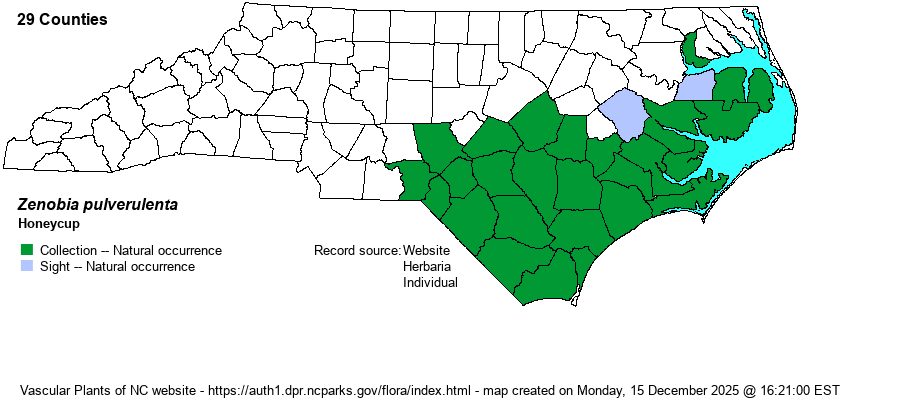| Author | (Bartram ex Willdenow) Pollard | |
| Distribution | Found throughout the southern 60% of the Coastal Plain, with scattered records in the northern portion. Not found in the Piedmont.
This is a near endemic to the Carolinas, ranging to southeastern VA and to one county in eastern GA.
| |
| Abundance | Fairly common to locally abundant, but somewhat restricted in habitats in many counties without extensive pocosins. Scarce in the northern 40% of the Coastal Plain. | |
| Habitat | This species occurs mostly in pocosin and bay habitats. It can be a dominant species in the center of extensive pocosins. It also is frequently seen along streamhead pocosins in the Sandhills region, as well as some beaver pond margins in pine-dominated habitats. | |
| Phenology | Flowers from April to June, after the leaves are grown; fruits in September and October. | |
| Identification | This is a monotypic genus, and thus no other species resembles Zenobia. It is a deciduous, strongly colonial shrub that grows from 3-10 feet tall, often wider than high owing to long arching branches. The leaves have strongly cuneate margins, making them easy to separate from other pocosin shrubs. In addition, one form of the species has quite glaucous leaves, being pale blue-green above and whitish below; however, other populations are green above and only somewhat paler below. It is spectacular in bloom, as it has long inflorescences of numerous clusters of large, white, bell-shaped flowers that can be seen from long distances. | |
| Taxonomic Comments | None
| |
| Other Common Name(s) | Zenobia, Dusty Zenobia; often called Honeycups or Honey-cups (plural) instead of simply Honeycup due to the numerous cup-like flowers. | |
| State Rank | S5 [S4S5] | |
| Global Rank | G4? [G4G5] | |
| State Status | | |
| US Status | | |
| USACE-agcp | OBL link |
| USACE-emp | FACW link |

